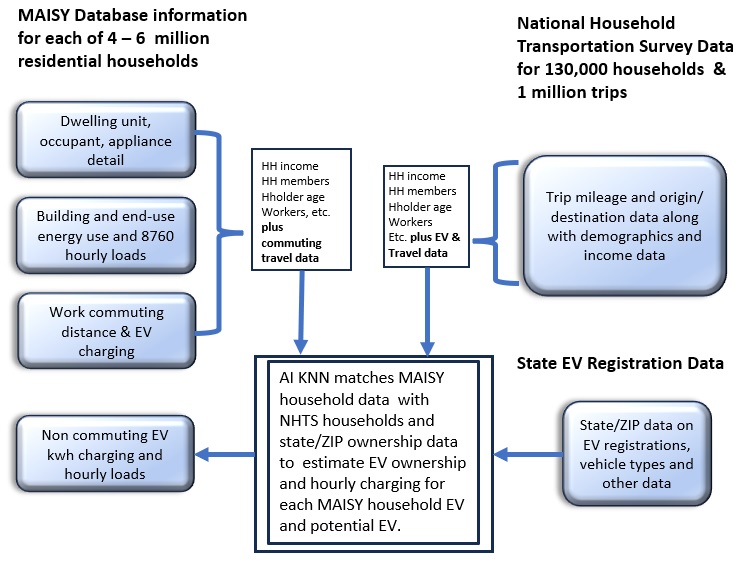Federal government EV purchase incentives along with a growing charging infrastructure and future lower price points are expected to
significantly increase EV ownership and charging loads (we are including both EV and PHEV (plug-in hybrid electric vehicles) in the term EV hereafter). These market changes create new challenges for electric utility distribution systems,
public charging station installation strategies, and impacts on microgrids.
The MAISY EV Hourly Charging Loads Databases are the first resource to provide a comprehensive small-geographic data (ZIP-level)
on both current and future potential EV charging
loads. Databases encompass the entire US with forecasts of future potential EV ownership and charging loads.
The EV Hourly Charging Loads Databases are developed using AI applications to integrate MAISY Database household work commuting
travel and charging loads, non-commuting travel and charging loads from travel survey data from 300,000 households (including details on 1 million trips), and
state/ZIP auto/truck registrations detail for individual PHEV and EV vehicles.
This process is illustrated in the schematic below:

Summary: EV Hourly Charging Loads Databases
-
EV hourly loads required to charge current PHEV AND EVs
-
Three EV future likelihood ownership categories for non-EV drivers
-
EV hourly loads required to charge future potential PHEV and EVs in each household
-
4 million single family households and 2.5 million multifamily households
-
AI-generated charging loads based on data from individual household commuting EV charging requirements,
300,000 household travel surveys with non-commuting trip details, and state/ZIP registration
detail for individual PHEV and EV vehicles.
-
Optionally, dwelling unit appliance loads can be included to provide total whole-house loads including charging loads
Hourly charging loads for potential EV owners support planning analysis for increases in total charging loads
with geographic areas down to ZIP code level.
Three potential ownership categories are 1- unlikely, 2- moderately likely, and 3-highly likely.
Providing hourly loads for current owners and for three potential ownership categories allows users to
quantify the likely impact of increasing ownership over time.
Vehicle owner demographic and income characteristics provide users with the ability to do what-if scenarios with their own EV adoption assumptions.
Ownership and potential ownership designations are based on statistical analysis of data on over 6,600 PHEV and EV owners across the US.
Example EV Hourly Charging Loads
The chart below on the left shows individual charging loads for a sample of household EV/Phev owners.
The chart on the right reflects cummulative loads from all the EV/PHEV owners included in the left chart.
MAISY EV Hourly Charging Loads Database Record Data Items
For each EV owner and potential owner record (up to 3 within a household):
-
Household and driver characteristics (income, household members, driver age, traffic congestion measures, etc.)
-
Ownership status (current EV owner or potential likelihood of ownership on a scale of 1-3)
-
Current hourly charging loads for current EV owners or hourly charging loads for potential EV owners
-
(Optional) whole building hourly loads with and without EV charging loads)
Data are provided in CSV formats with data items for each household/driver on a single database row.
|